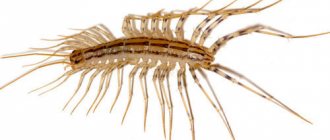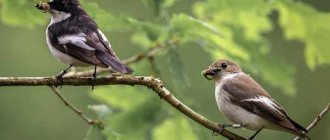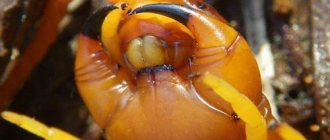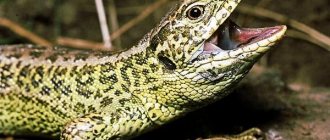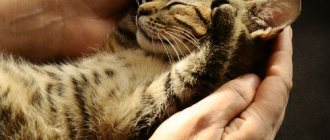A centipede encountered in one's own apartment often terrifies people. An insect running quickly seems dangerous and aggressive. In fact, such statements have a basis. The centipede insect is a predator; it is indeed capable of attacking and biting, but not a person, but a fly or moth. She tries to avoid contact with people, hiding in hard-to-reach corners. If there is a clear threat, the centipede may bite; the insect's venom causes problems for people with allergies.
Appearance of a centipede
The common flycatcher, which we call the centipede, belongs to the large family of centipedes. It has 12,000 species. The flycatcher has a flat body divided into 15 segments. Each segment corresponds to a pair of legs. The first pair, as a result of evolution, turned into jaws designed for capturing prey. It is not difficult to calculate how many legs a centipede has - 30. The number of limbs depends on the age and type of insect, the maximum number is 354. All centipedes have an odd number of pairs of legs.
Interesting fact. The last pair of legs significantly exceeds the length of the remaining limbs. In female flycatchers it is twice the size of the body. From the outside, these legs look like antennae, so at a quick glance it is difficult to determine where the insect’s head is.
The size of the flycatcher is 35-60 mm, an adult running at a speed of 40 cm/sec can make an unforgettable impression.
On the sides of the head there are compound eyes. The insect has excellent vision, which helps in hunting. The long antennae of the flycatcher consist of hundreds of small segments. It has an exoskeleton of chitin and sclerotin, a distinctive feature of all arthropods. The body of the insect is grayish-yellow with three dark stripes along its entire length. Purple stripes are also noticeable on the flycatcher's many legs. Knowing what a centipede looks like, it cannot be confused with another type of centipede - the centipede. This insect is much more dangerous; its bite is strong and causes painful swelling.
Features of character and lifestyle
Photo: Black centipede
Centipedes are predominantly nocturnal, but can also be found during daylight hours in shaded areas. Flycatchers are true sprinters among all their relatives. If at rest this creature presses tightly to the surface, then while running it raises its body as much as possible.
Excellent eyesight and sense of smell, a special structure of the legs that allows them to stay on steep walls, made centipedes excellent hunters. Thanks to the flexibility of the body, they are able to penetrate even the narrowest crevices. For normal life functions, a lot of energy is needed, so they are almost constantly in search of food, tracking down unwary flies or spiders.
Sometimes centipedes are called centipedes, although these creatures have a lot of differences, and not only in appearance. Scolopendras, which live primarily in the tropics, are not as harmless as their centipede relatives. Their poisonous bite can cause significant harm to human health, including death.
Interesting fact: After touching centipedes, you must wash your hands and never touch your eyes, since there are poisonous glands on the sides of the body of these creatures, and the poison can cause severe irritation of the mucous membranes.
Habitat
The common flycatcher can be found in many temperate regions. In Russia, this is the Volga region, the southern regions, the insect lives in the northern part of Africa, Europe, the Middle East, and Mediterranean countries. Under natural conditions, centipedes hide under stones, fallen leaves, and plant remains. The domestic centipede hunts at any time of the day.
They move to human housing with the onset of autumn cold weather. Prefer dark and damp places:
- basement;
- bathroom;
- toilet.
During the winter, the insect hibernates and becomes active only when the weather warms up. In southern countries, centipedes are treated kindly, because they help exterminate pests.
Boric acid
Boric acid is considered an effective remedy for getting rid of centipedes in the house. It can be used in any form: both in powder form and in the form of an alcohol solution. If ingested or on the body, boric acid causes a severe burning sensation that usually leads to the death of the centipede.
It is enough to scatter the powder in those places where flycatchers most often appear. An alcohol solution of boric acid should be applied to walls, floors and baseboards using a spray bottle. Caution should be used when handling any form of the substance.
How do flycatchers hunt?
They lie in wait for their prey using antennae that detect odors and vibrations. During a hunt, the centipede rises on its long legs, then rushes with lightning speed at the spotted prey. To hold it, powerful jaw processes are used. The injected poison instantly paralyzes the insect. After eating, the flycatcher hides in a secluded place to digest food. When faced with a flycatcher, people often wonder if the centipede is poisonous. Yes, the insect has glands that produce poison to kill prey.
If there are several victims within the centipede's reach, it catches them all. Moreover, in the process of eating one midge, she holds the rest with her legs.
Are they eaten?
As a food item in China, certain large-sized species are consumed, usually grilled or deep-fried. They can often be seen in the stalls of street vendors in large cities, in the Donghuamen and Wangfujing Beijing markets.
Also in China, Laos, Thailand, Cambodia, large centipedes are made into a tincture and dried. This custom is part of traditional Chinese medicine. It is believed that they have medicinal properties and give strength; liqueur with a centipede immersed in it is used as a special medicinal drink.
Reproduction of centipedes
During the breeding season, the female begins to secrete pheromones that attract the male. The mating process of insects takes place in a unique way. The male deposits a sperm capsule. The female picks up the spermatophore with her genital appendages. The number of fertilized eggs laid ranges from 60 to 130 pieces. The common flycatcher digs a hole for them in moist soil, then covers them with a sticky substance.
Centipedes are born with four pairs of legs. Their number increases after each molt. It will take at least five molts until the number of legs reaches 15 pairs. Under natural conditions, insects live 3-7 years.
Symptoms of a scolopendra bite
Owners of terrariums do not have to guess what insect bit them. It's a completely different story when it comes to people who encounter this centipede in the wild.
It is important to know what a centipede bite looks like so you can distinguish it from damage caused by other insects.
Characteristic signs of a bite:
- two puncture wounds located at a short distance from each other.
- Severe pain that occurs when bitten.
- A sharp increase in body temperature up to 390C.
An aggressive insect may bite repeatedly if it is not immediately shaken off and thrown away.
Centipedes in the house, why are such neighbors dangerous?
The appearance of a flycatcher in a house does not threaten its residents. The insect is more active in the dark, so the risk of encountering it will increase at night. When the light is turned on, the centipede rushes to a secluded crevice. If a centipede is spotted in a house in the summer, it is better to catch it and take it outside. You need to catch it not with your hands, but with a can or box. In tropical countries where there are no harsh winters, flycatchers do not migrate into houses.
Having settled next to a person, the insect does not encroach on his food, plants and pets. Centipedes do not chew furniture or wallpaper and are not carriers of dangerous diseases. There will also not be an invasion of large numbers of flycatchers; they do not live in families. You can get along peacefully with them, even benefiting from such a neighborhood. The little predator copes well with annoying flies, and if cockroaches are hiding in the apartment, the centipede will get to them.
Is the centipede dangerous for humans? If there is a clear threat to life, such as a pet or human attack, it may bite and inject venom under the skin. A small dose of a paralyzing toxin is not lethal to pets, much less to people. It causes an unpleasant sensation, but no more than a bee sting. A tendency to be allergic to insect venom can aggravate the situation, causing swelling and general malaise.
Do centipedes bite?
Even the most non-aggressive creature can bite out of fear. A flycatcher, even if it attacks an adult, in most cases will not be able to bite through the skin. Children's skin is more delicate and thin, so getting wounds is real. Symptoms of toxin entering the body include redness, itching and burning. What to do if bitten by a centipede? The first piece of advice is don't panic. The poison is very weak and will not cause any harm to health. It is worth acting according to the circumstances:
- disinfect the wound with alcohol or hydrogen peroxide;
- if there is a strong burning sensation and swelling, you should apply a cold compress and hold it until the discomfort disappears;
- if the bite site hurts, take an antihistamine and pain reliever.
Attention. Individual intolerance to flytrap venom can lead to complications. If symptoms of an allergic reaction appear - weakness, dizziness, breathing problems and others, you should go to the hospital.
How to get rid of a flytrap
Not everyone likes the presence of an unpleasant insect in the house, which can fall from the wall directly onto anyone’s head. Many people are afraid of a centipede bite and its consequences. A change in the conditions that are comfortable for it can force the common flycatcher to leave its favorite place. Simple and affordable actions against centipedes:
- The flycatcher loves dampness - it is necessary to ensure a normal level of humidity. Wipe up puddles on the floor in a timely manner, fix leaking taps, and do not leave wet wipes or rags on.
- Airing and good ventilation also reduce humidity in the room.
- Check the basement; there is often an accumulation of rotten boards, old paper, mold and dampness.
- Try to deprive the flytrap of food, destroy flies, cockroaches and other prey yourself.
- Block possible routes of entry into the house - fill cracks with mortar, put screens on windows, repair cracks in the wooden floor.
Attention. Sticky insect traps placed on the floor will not help get rid of the common flycatcher. She runs away from the tape, leaving several detached legs on the surface. This is a small loss for the centipede, because the legs grow back over time.
The centipede or flytrap is not the most pleasant neighbor, but it is useful. Various insect parasites exist hidden in every home. The predatory centipede effectively destroys pests. If you ignore her repulsive appearance, it will be a mutually beneficial partnership.
Reasons for appearance
In their natural environment, centipedes live in damp places where there are many small insects for food. And in residential buildings, an “invasion” of flycatchers is observed in late autumn, when it becomes cold outside, and these creatures have to look for shelter and food.
Despite the fact that the appearance of a centipede may well frighten even an adult, it does not pose a serious danger to people.
Millipedes easily make their way into apartments, even on the highest floors, through cracks in walls and ventilation ducts. Since moisture is vital for them, they most often settle in bathrooms or in the kitchen, closer to the sink. And in private homes, basements and attics become their favorite habitat.
The venom of this arthropod is harmful exclusively to insects (cockroaches, bedbugs, flies, etc.)
Flycatchers are nocturnal creatures, so it is almost impossible to notice them during the day. But when it gets dark, they go out hunting and move around the apartment very quickly.
Interesting fact: a centipede can catch several insects at once with its legs.
In fact, the house centipede can be very useful - it destroys harmful insects.
Nutrition
All representatives of the superclass are predators. They usually eat:
- ants and their larvae;
- domestic cockroaches;
- flies, ticks.
Some species, such as the giant and ringed scolopendra, found in South America and Jamaica, are capable of hunting mice, frogs and lizards.
Centipedes use poison to paralyze and kill their victims. However, there is no need to be afraid of them: the poison produced by centipedes is harmful only to small arthropods, but not to mammals. In rare cases, the poison can provoke allergies.
Centipedes feed as follows. Having caught the victim, they inject poison into them and hold it with strong jaws and paws until the insect is completely immobilized. Only after this do they start eating.
Centipedes also destroy insects that harm agriculture. In some countries, for this reason they are under government protection.
Evolution
Millipedes are among the first animals to colonize the earth during the Silurian period. Early forms ate mosses and primitive plants.
There are two main groups of millipedes, all members of which are extinct: the archipolipods (“ancient, many-legged”) and the arthropleurids, the largest known terrestrial invertebrates.
The earliest known land creature, Pneumodesmus newmani, was a 1 cm long archipolypodanus that lived 428 million years ago.
Live bands
- Octoglena Sierra;
- Octoglena sierra (Colobognatha, Polyzoniida);
- Anadenobolus monilicornis;
- Anadenobolus monilicornis (Juliformia, Spirobolida);
- Harfafa Haydeniana;
- Harpaphe haydeniana.
The history of scientific classification of centipedes began with Carl Linnaeus, who, in the 10th edition of Systema Naturae, 1758, named seven species “Insecta Aptera” (wingless insects).
Life cycle
Mated females lay eggs in the soil. Some species lay them singly, others lay them in clusters. Depending on the type, the female can lay from several tens to several thousand eggs during her life.
Find out more Why does a rabbit bite and what to do
Millipedes undergo incomplete metamorphosis. Once the young hatch, they remain in the underground nest until they have moulted at least once. With each molt they get more body segments and more legs. It takes many months to reach adulthood.
Defense Mechanisms
Due to their lack of speed and inability to bite or sting, centipedes' primary defense mechanism is to curl up into a tight spiral, protecting their thin legs inside an armored exoskeleton.
Many species secrete various foul-smelling liquids as a secondary defense through microscopic openings called ozopores located along the sides of the body.
Among the many irritating and toxic chemicals contained in the secretions are alkaloids, benzoquinones, phenols, terpenoids, and hydrogen cyanide.
Some are caustic and can burn the exoskeleton of ants, other insects, and the skin and eyes of large predators. Primates such as capuchin monkeys and lemurs have been observed deliberately irritating centipedes and rubbing chemicals on themselves to ward off mosquitoes.
Some of the protective compounds exhibit antifungal activity.
The bristly centipedes (order Polyxenida) lack an armored exoskeleton and stink glands. Instead, they are covered with numerous bristles, which Polyxenus flaviculatus separates and launches at the ants.

